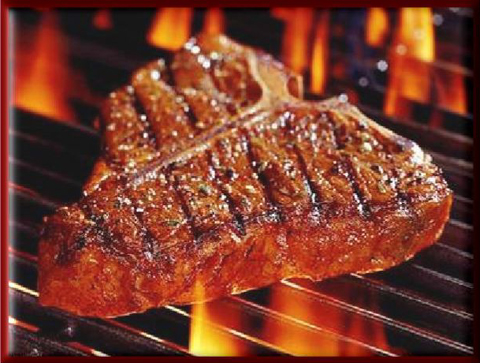
Today’s guest blog is by our friend Craig “Meathead” Goldwyn
and from his great website AmazingRibs.com. I get a lot of positive feedback on his posts so here’s another one. If you put “Craig” in the search box you can find his other posts. Enjoy!
This information has been updated to include the revised USDA recommendations of 5/24/2011.
I want my meats tender, juicy, and flavorful, and I also want them safe. The temperature of the meat controls these things. Heat kills bacteria, and the color of the meat changes with temperature.
The internet and a lot of cookbooks tell you that you can tell when meat is ready by poking it and comparing its resistance to the flesh on your hand.
This is utter nonsense! The resistance of the steak is going to depend on what cut of meat you are poking, the grade of meat, how thick it is, the age of the steer, the breed of steer, the age of the meat, and what the steer was fed, among other things. A prime grade filet mignon feels a lot more tender than a choice grade sirloin. A 3″ ribeye feels different than a 1″ ribeye.
In addition, the resilience of our hands differs from young to old, from thin to fat, from exerciser to couch potato.
It is true that top steakhouse chefs can tell a steak’s internal temp just by poking it. But they have poked thousands of steaks, all from the same supplier, all the same thickness, all cooked at the same temp.
The rest of us need a thermometer. Meat is expensive. It is costly and embarrassing to overcook it. Friends and family are priceless. It is not nice to sicken or kill them.
Doneness and color are controlled by one thing and one thing only, the temperature of the meat. For home cooks, there simply is no substitute for a good digital instant thermometer like the ones I recommend in my Buying Guide to Thermometers.
Here’s what the US Department of Agriculture (USDA) says: “The color of cooked meat and poultry is not always a sure sign of its degree of doneness. Only by using a food thermometer can one accurately determine that a meat has reached a safe temperature. Turkey, fresh pork, ground beef or veal can remain pink even after cooking to temperatures of 160°F and higher. The meat of smoked turkey is always pink.” In addition, smoked meats are often pink due to a chemical reaction with the smoke, rare hamburgers can be brown, and chicken cooked well above the safe temp can still have bloody splotches.
Here are the temperatures a cook needs to know. You also need to know that these temps are not exact. Some cuts may go medium at a lower temp than others, and certainly the dividing line between rare and medium rare (etc.) is not hard and fast.
IMPORTANT DISCLAIMER. Most chefs recommend medium-rare for optimum flavor, texture, and juiciness. That temp is below the recommended temps in the USDA guidelines which are designed for maximum safety. The USDA recommendations for chicken, turkey, eggs, and ground meats should be followed strictly. The risks are too high. The risks of medium-rare on other foods are low but not zero. All this notwithstanding, my lawyer wants me to tell you that I am a cook and not a food safety expert and I cannot be responsible for your health or safety if you do not follow USDA guidelines exactly.
* Veal colors are similar to pork. USDA recommended temps for duck are the same as for turkey and chicken.
** These cuts are safe at much lower temperatures, but because they are high in connective tissue and fat, they taste and feel best if cooked to 180 to 190°F at low temperatures such as 225°F. This is the secret to great barbecue and the best methods are discussed in detail on AmazingRibs.com.

